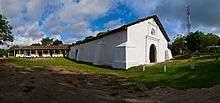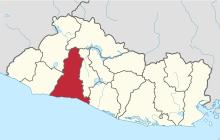Huizúcar
| Huizúcar | |
|---|---|
| Municipality | |
 Huizúcar Location in El Salvador | |
| Coordinates: 13°35′N 89°14′W / 13.583°N 89.233°WCoordinates: 13°35′N 89°14′W / 13.583°N 89.233°W | |
| Country |
|
| Department | La Libertad |
| Elevation | 2,000 ft (610 m) |
Huizúcar is a municipality in the La Libertad department of El Salvador. The town of Huizucar is the head of the district of the same name in the department of La Libertad, at 23 km. away from San Salvador and with an elevation of 640 meters over the sea level.
Church Of Huizúcar

The church was built in the year of 1740. It is not known who built it but it is supposed that the plan was made by Friar Martín de Jesús.
It possesses interesting characteristics like the Mudejar style of the crisscross in the keys or suspenders which is the outstanding element. It's totally built in wood with armors of even roofs and big beams resting on thick wooden pillars whose basements are molded of brick.
The facade is of a single body and presents a triangular forehead on the roof that is made of cover with molded figures. In the facade the ornamental element is a niche where San Miguel Archangel's image has been placed, patron of the town, which is elaborated of masonry and embedded to the wall.
Its interior is of three simple ships limited among them by 18 columns. It has walls of 1.40 of width, made of adobes and together with cement of mud. The presbytery is of rectangular plant and its cover is a dome of coffered Mudejar type. An arch with vegetation designs separates the presbytery from the ship.
The altarpieces are carved in wood and they even conserve vestiges of bread of gold of their Baroque style. It has images, pictorial works, and altars of Baroque style.
The last time that the church was remodeled was in 1974; being in charge the Direction of Sites in order to return the original design that had been altered in previous remodeling.
The state of the building when the restoration began was of advanced deterioration, being noticed that its structures and covers presented strong damages caused by humidity, termites, and other plagues.
The wooden structures, particularly of the roof, were semi-destroyed. The walls presented long and deep cracks and they had swollen up through the action of water and tremors.
The main facade was obstructed completely by a piazza and a tower of recent construction. The tower, placed on the left corner buttress, destroyed it partially because it had been lifted to serve as steeple.
The piazza and the steeple lacked historical value, for which they were suppressed to leave free the original construction, which was the purpose of the restoration.
Most of the pieces of the roof ceiling, like props, feathers, beams, and others, were substituted for new ones, and the coffers of Mudejar style were armed again. The walls were healed, stuffing the cracks and holes, proceeding in equal forms with the buttresses, three of them were reconstructed totally. All the walls were sealed and were whitened with lime.
The foundation of this village is very previous to the colony. Its autochthonous name means: "Place on the way of the thorns." In the report of Monsignor Pedro Cortez and Larraz of the year 1770, Huizucar was a small town annex to the rectory of San Jacinto, where 200 families lived.
There is also data of San Salvador Mayor, Don Manuel de Gálvez Corral that says that in 1740, it had 220 tributary Indians or heads of household (that is to say, about 1100 inhabitants). The Patron Festivity takes place on September 29 in honor of San Miguel Archangel.
Gallery
 Streets of Huizúcar, looking south
Streets of Huizúcar, looking south Looking to the north
Looking to the north Streets of Huizúcar
Streets of Huizúcar Looking to the east
Looking to the east
